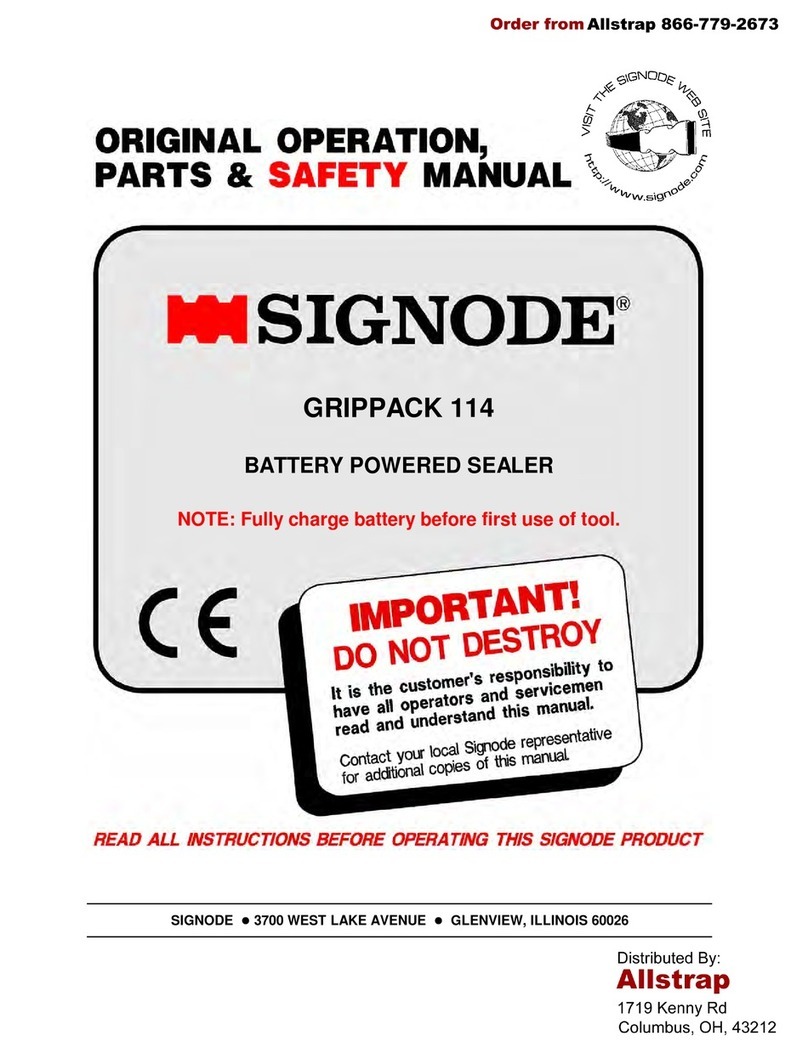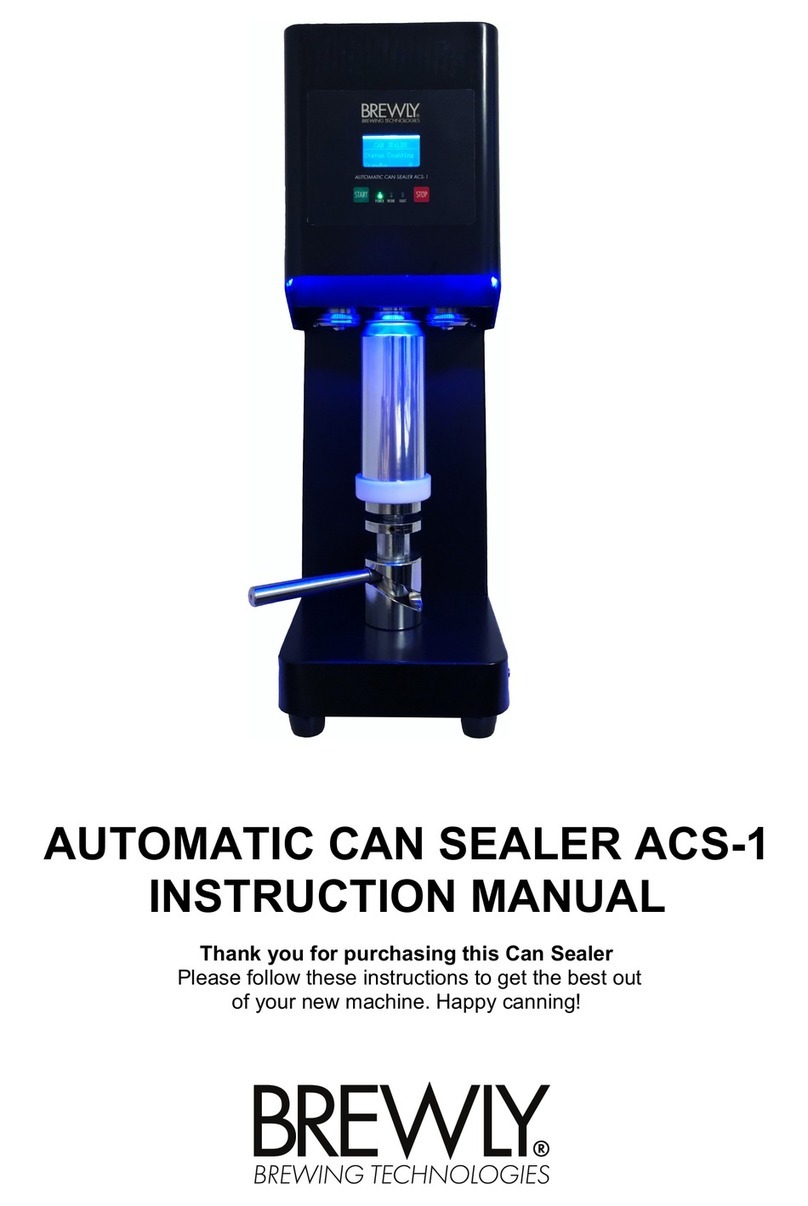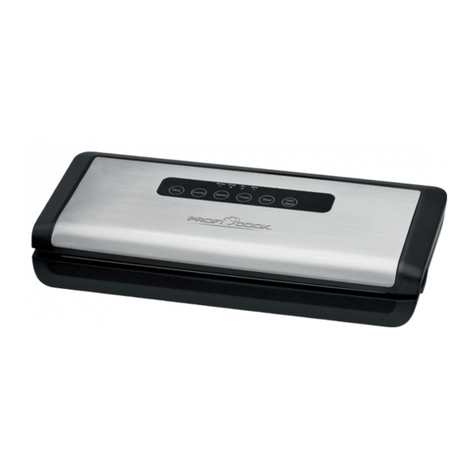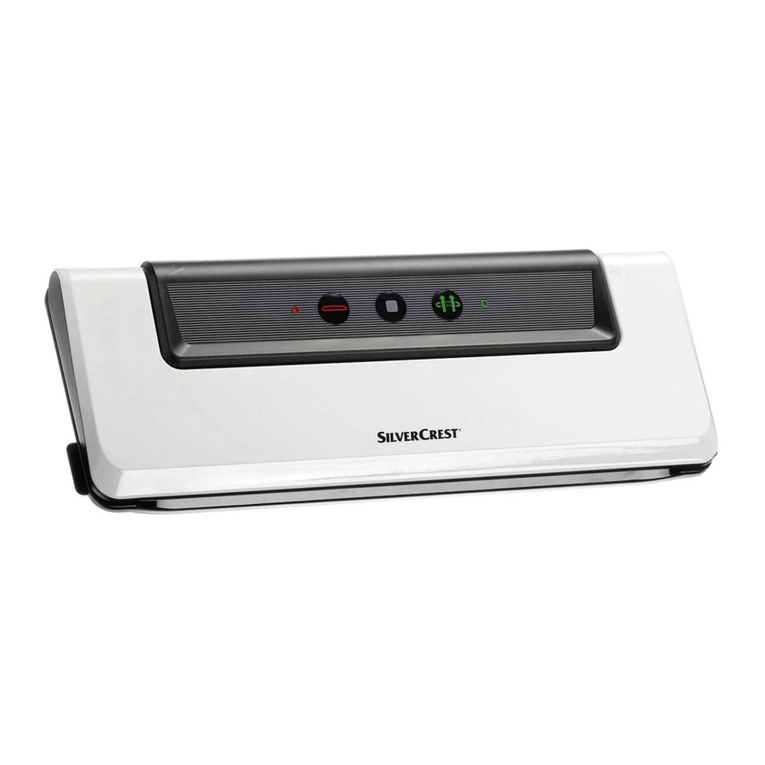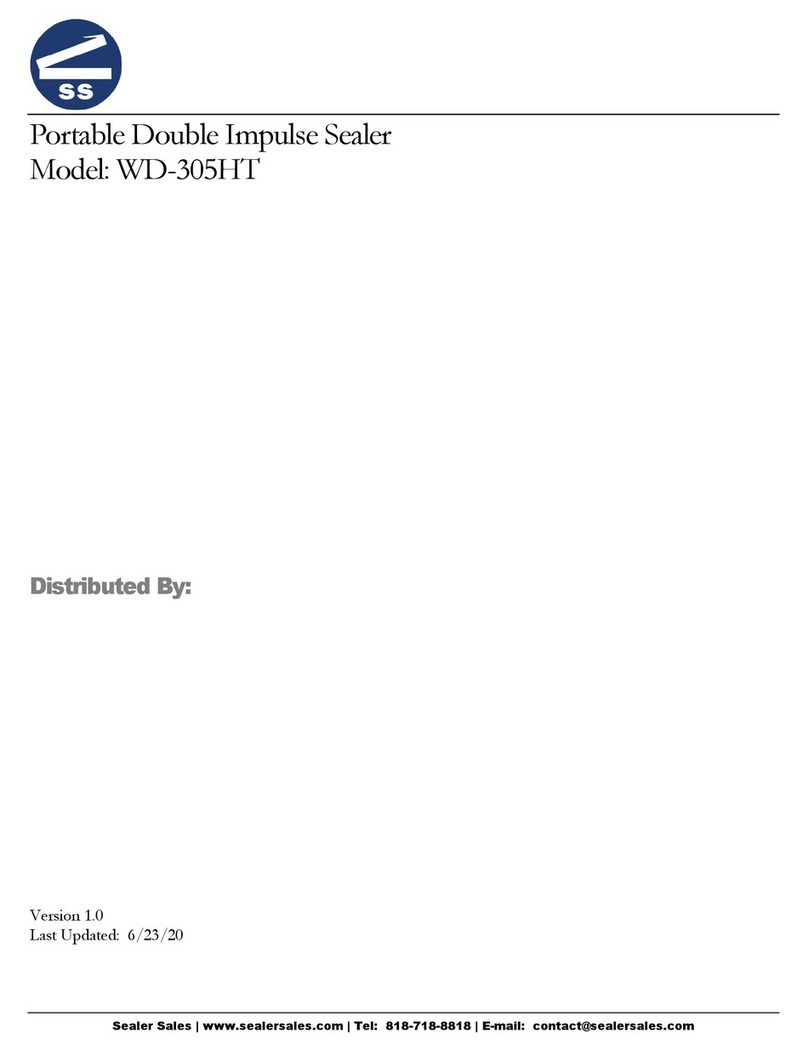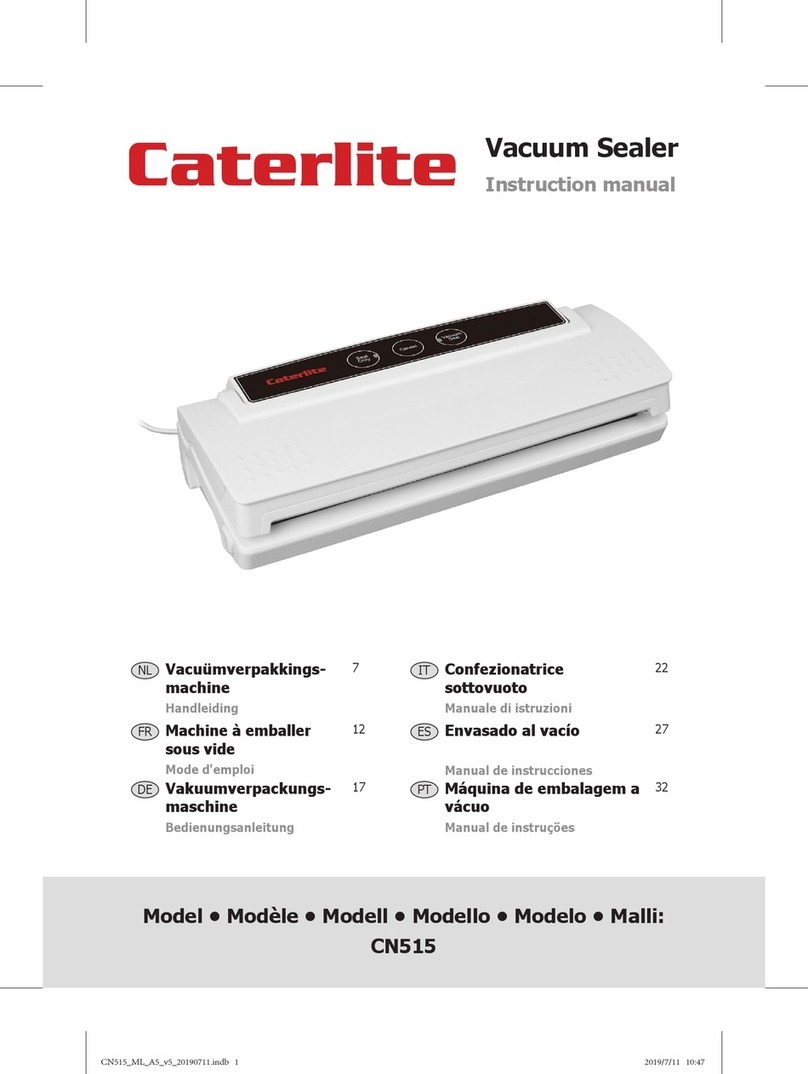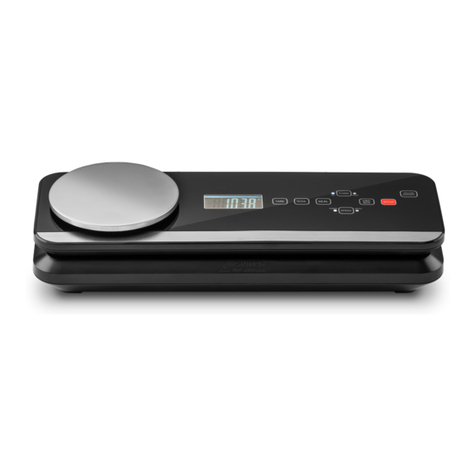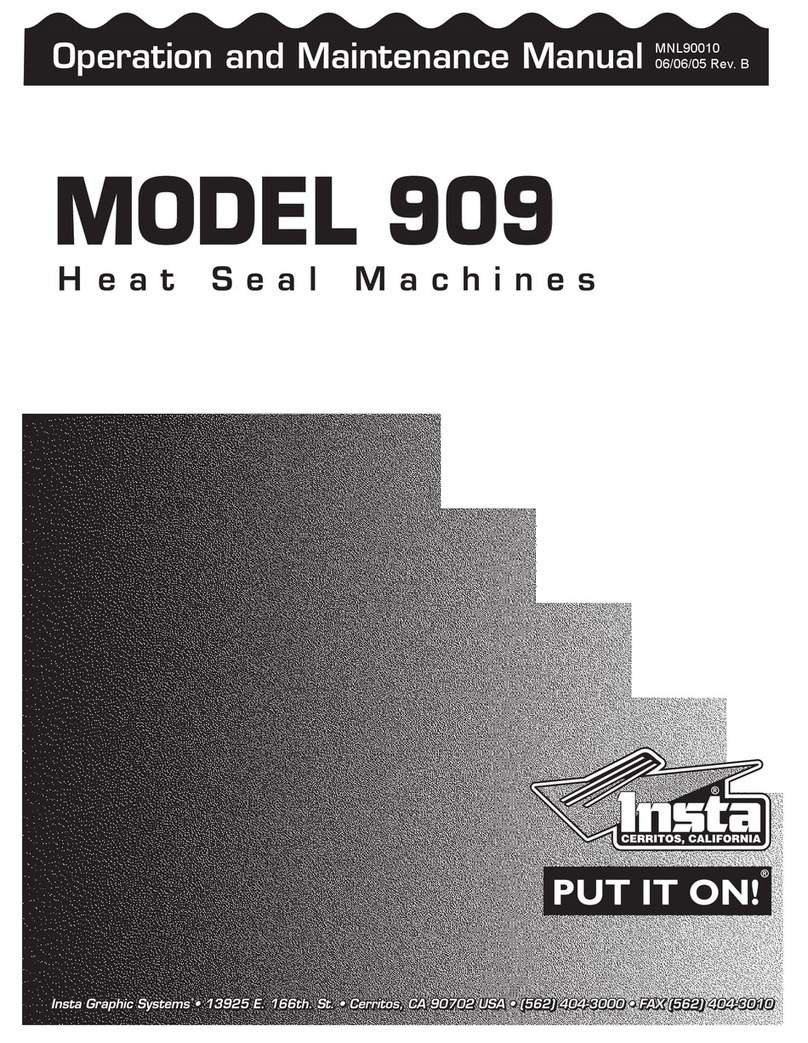Gemini GVS12 User manual

1
MODEL NO 型號: GVS12
120W
VACUUM SEALER
真空保鮮機
A GILMAN GROUP BRAND

2
1. Carefully read all of the instructions before using this appliance and save for
future reference.
2. Before plugging cord into wall outlet, or disconnecting, make sure that the
cover of the machine is in unlocked condition, and unplug from outlet when
not in use or before cleaning.
3. This appliance is not a toy, when used by or near children, close attention is
necessary, and store this appliance to a safe place, out of the reach of children.
4. Do not use any bags or attachments not recommended or appointed, and do
not use this appliance for other purpose except its intended use.
5. Stop using the machine immediately if the cord is damaged and have it re-
placed by a professional.
6. Keep away from moving parts.
7. Do not contact the hot sealing element located on edge of the top cover of
this machine. It is hot and may get burn.
8. Do not try to repair this appliance by yourself.
9. Do not hit the machine or make it fall on the oor, do not use the appliance if
it has fallen or appeared to be damaged.
10. Avoid to do the following: pull or carry by the cord, use the cord as a handle,
close a door on the cord, or pull the cord around sharp edges or corners. Do
not operate appliance over the cord or when cord / plug is wet.
11. Keep away from hot gas, heated oven, electric burner or any other hot sur-
faces. Do not use this appliance on wet or hot surface or near a heat source.
12. It is better not to use an extension cord with this unit. However, if one is used,
it must have a rating equal to or exceeding the rating of this appliance.
13. When disconnect, to avoid any injury, please unplug by grabbing the plug,
not the cord.
14. Before plugging appliance in or operating, make sure your hands are dry and
safe to do the actions.
15. Always place the appliance on a stable surface, such as table or counter dur-
ing operation.
16. It is not necessary to use any lubricant, such as lubricating oils or water, on this
appliance.
17. Do not immerse any part of this appliance, power cord or plug in water or any
other liquid.
18. Do not use this appliance outdoors or on a wet surface, it is recommended for
household and indoor use only.
When using this electrical appliance, safety precautions should always be
observed, including the following:
SAVE THESE INSTRUCTIONS FOR HOUSEHOLD USE ONLY
OPERATION TIME: 1 MINUTE PER CYCLE
READ ALL INSTRUCTIONS
IMPORTANT SAFEGUARDS

3
FUNCTIONS
1 2 3 5 4
19. This appliance is not intended for use by persons (including children) with
reduced physical, sensory or mental capabilities, or lack of experience and
knowledge, unless they have been given supervision or instruction
concerning use of the appliance by a person responsible for their safety.
20. Children should be supervised to ensure that they do not play with the appliance.
21. Do not lock the cover after use to avoid long time sealing rings compression
and cause damage.
1. Vacuum + seal / Cancel button:
• This button has two functions depending on the machine status:
• At stand-by condition, it starts the automatic operation of vacuuming the bag and
then seals the bag when vacuum process is completed.
• At operating condition (vacuuming or sealing), it stops the machine.
2. Food button: Used for choosing the best heat seal time
• Dry setting : for dry bags and items without moisture, requires a shorter heat seal-
ing time;
• Moist setting: for wet bags or foods with moisture, requires an extended heat seal-
ing time.
• Default setting is for dry bags and normal sealing time.
3. Pump button: For choice of different vacuum pressure
• Normal setting: for regular items storage in normal vacuum pressure ;
• Turbo setting: for more vacuum with higher pressure.
• Default setting is “Normal” vacuum pressure.
4. Seal button: This button provides two functions:
• To manually seal the open end of a bag without vacuuming air suction, used to
make a bag from a bag roll;
• When the automatic “VACUUM + SEAL” function is in operation, this button stops
the motor pump and immediately starts to seal the bag so that less vacuum pres-
sure inside the bag can be controlled by the user to avoid crushing of delicate items.
5. LED Indicators: Indicate the status of vacuum or seal process and the status of the
machine setting.
- Vacuum+Seal / Cancel (ON: Red light ; Complete: Red light off)
- FOOD / PUMP (ON: Red light)
- SEAL (ON: Blue light ; Complete: Blue light off)

4
6. Release Button (Left & right of the machine): Press the button on both sides to
open the cover or release the vacuum pressure inside the machine.
7. Air intake: To vacuum the air from vacuum bag.
8. Sealing strip: Place the bag to be sealed over this strip.
9. Vacuum chamber: Position the open end of the bag inside the chamber, draws air
out of bag and catches any liquid overow from the bag.
10. Lower gasket: Keep air away by forming vacuum chamber with upper gasket in the
vacuum chamber. Clean and dry or replace it when it is distorted or broken.
11. Upper gasket: Keep air away by forming vacuum chamber with lower gasket. Clean
and dry or replace it when distorted or broken.
12. Sealing element: Heating element which generates heat and seals the bag.
13. Lock: To lock the cover to the base.
111213
68 7 9
10

5
OPERATING INSTRUCTIONS
I. Making a bag from a bag roll (Need to
purchase separately)
1. Plug the unit into a power source;
2. Use scissors to cut a bag from the bag rolls
to the desired length (Pic.1)
3. Put one end of the bag on top of the sealing
strip, but not enter the vacuum chamber (Pic.2)
4. Close the upper lid and press tightly until it is
clicked in place on both sides of release buttons
(Pic.3)
5. Press Seal button to start sealing the bag
(Pic.4). After the process is completed, the blue
light indicator will turn off.
6. Press the release buttons to open the cover
and take the bag out of the machine, one end of
the bag is sealed (Pic.5)
Two sets (total 10 pieces) of vacuum bags are
equipped in the package. One end of the bag is
already sealed. Seal the other end after placing in
the items for storage.

6
II. Vacuum packaging with a bag
1. Put the foods/items inside the vacuum bag. Use
only the food grade standard vacuum bags
supplied by us with vacuum channel. Not to
use other vacuum bags to avoid any risks and
damage the machine.
2. Clean and straighten the open end of
the bag, make sure there is no dust, wrinkle or
ripples.
3. Place the open end of the bag within the
vacuum chamber area (about 3-5mm edge over
the vacuum chamber). Make sure the air
intake is not covered by the bag. (Pic.6)
4. Press the cover down on both sides using
both hands until click sound is heard from the
release buttons. (Pic.7)
5. Choose the option from the “FOOD” button
and the “PUMP” button. The vacuum and sealing
time depends on the type of food packed (moist
or dry) and desired vacuum pressure (Normal/
Turbo) setting.
6. Then press “VACUUM + SEAL” button, the ma-
chine start to vacuum and will seal the bag auto-
matically (Pic.8)
NOTE:
This machine provides very high vacuum presssure
during vacuum packaging with a bag, in order to
avoid crushing of the delicate item by the high
vacuum pressure, observe the status of the
vacuum pressure inside the bag and switch off
the “VACUUM + SEAL” button immediately
when the desired vacuum pressure is achieved.
The machine will then stop the pump and start
to heat-seal the bag. The red light of “VACUUM
+ SEAL” & blue light of “SEAL” will turn off when
pressed the “CANCEL” button.
7. The vacuum packaging is done. The red light
of “VACUUM + SEAL” & blue light of “SEAL” will
turn off. Press the release buttons on both sides of
the machine simultaneously to open the cover and
take out the packed bag (Pic.9)

7
NOTE:
• For the best sealing effect, it is better to let the
machine cool down for 1 minute before using
it again. Wipe out any excess liquid or food
residue in the vacuum chamber after each
bag packaged.
• Do not seal one bag after another continu-
ously to avoid overheat of the sealing element.
The machine will not function if this “seal”
button is activated within 15 seconds of the last
activation.
• Your appliance can only work on the food grade
vacuum bags.
• Cut the bag straight across with scissors to
open a sealed bag.
III.Cord storage box
After use, put the power cord into the storage box located at the back of the machine.
Do not wrap the cord around the machine.

8
1. Do not put too much stuff inside the bag: leave enough empty space in the open end
of the bag so that the bag can be placed in the vacuum chamber area without creating
wrinkles or ripples;
2. Do not wet the open end of the bag. Wet bags will cause difculty to heat-seal tightly.
If the food has moisture or the bag is wet, you can choose the ‘Moist’ function which
is designed for a longer sealing time and seals better for wet bags.
3. Clean and straighten the open end of the bag before sealing. Make sure nothing is left
on the open area of the bag, no wrinkle or creased lines should appear on the open
panel, foreign objects or creased bag may cause difcult to seal tightly.
4. Do not leave too much air inside the bag. Press the bag to allow extra air to escape
from the bag before vacuuming it. Too much air inside the bag increases the vacuum
pump loading and may cause the motor insufcient power to draw away all the air
inside the bag.
5. Do not vacuum packaging objects with sharp points like sh bones and hard shells!
Sharp points may penetrate and tear the bag! You may use a thicker bag to cover the
object before placing into the vacuum bag.
6. Suggest to vacuum seal one bag within 1 minute.
7. If vacuum is not performed properly, the vacuum system will shut automatically after
60 seconds. In this situation, please check if the bag is leaked or not placed properly
or any other reasons.
8. Make sure there is no crack or deformation or small particles resting on the foam gas-
kets around the vacuum chamber. When this happens, take it out and wash and dry it
thoroughly, or replace with a new one.
9. During vacuum packaging process, small amounts of liquids,
crumbs or food particles can be inadvertently pull into the vacuum
chamber, clogging the pump and damaging your appliance. To
avoid this, freeze moist and juicy foods rst before sealing bags
or place a folded paper towel near the inside top of the bag. For
powdery or ne-grained foods, avoid overlling bags. You may
also place a coffee lter near the open end of bag before vacuum packaging.
10. For objects with sharp points and edges, such as bones or dried pasta, pad the edges
with paper towels to keep them from puncturing the bag.
11. Pre-freeze fruits and blanch vegetables before vacuum packaging for best results.
12. Store perishable foods in the freezer or refrigerator. Vacuum packing extend the shelf
life of foods.
13. Fill a bag about 2/3 full with water, seal the end (do not vacuum). Freeze the bag and
use for ice in the cooler or ice packs for sports injuries.
14. Many foods are sold pre-packed in commercial vacuum bags such as cheese and
deli meats. Now, you can maintain the taste and freshness of these foods, by
re-packaging with the vacuum sealer bags after the commercially packed bags have
been opened.
15. Items such as our, rice, mixed for cakes and pancakes, all stay fresher longer when
vacuum packed. Nuts and condiments maintain their avor while rancidity is kept out.
16. There are many non-food uses for vacuum packing. Keep camping supplies such as
matches, rst aid kits and clothing clean and dry. Keep silver and collectibles untarnished.
NOTE:
After nished the vacuum work, please always keep the machine cover open, do not
fasten the cover, it will deform the form gaskets and affect the machine function.
HINTS FOR BEST VACUUMING PERFORMANCE AND APPLICATIONS

9
Vacuum sealer
1. Always unplug the machine before cleaning.
2. Do not immerse in water or any other liquid.
3. Avoid using abrasive products or material to clean the machine as they will scratch the
surface of the machine.
4. Use mild dishwashing soap and a warm, damp cloth to wipe away food residue on the
machine.
5. Dry thoroughly before using again.
NOTE: The foam gaskets around the vacuum chamber should be dried thoroughly before
re-assembling. When re-assembling, be careful to prevent any damage, and assemble
back to the original position to ensure no vacuum leaking.
Vacuum bags
1. Wash bags in warm water with a mild dishwashing soap.
2. When wash bags in dishwasher, turn bags inside out and spread them over top rack of
dishwasher, so entire surface is exposed to the washing water.
3. Dry thoroughly before reusing.
IMPORTANT: To avoid possible illness, do not reuse bags after storing raw meats, raw
sh or greasy foods. Do not reuse bags that have been microwaved or boiled.
Storing Your Vacuum Sealer:
1. Keep the machine in a at and safe place, out of reach from children.
2. Please keep the cover lid UNLOCK when not in use and in storage to prevent distort
of foam gasket that may cause air leakage.
CLEANING AND MAINTENANCE

10
Nothing happens when I try to vacuum package
1. Check power cord to see if it is rmly and correctly plugged into electrical outlet.
2. Examine power cord for any damages.
3. See if electrical outlet is operative by plugging in another appliance.
4. Make sure it is set to the correct mode. Refer to the above operating instructions.
5. Make sure the bag is placed correctly inside the vacuum chamber and beneath the
air intake.
Air is not removed from the bag completely:
1. To seal properly, open end of bag should be resting entirely inside vacuum chamber area.
2. Check sealing strip and the foam gasket beneath the lid. Make sure no breaking or dis-
tortion of the foam seal gaskets on both the cover and on the base around the vacuum
chamber.Wipe clean and smooth them back into place.
3. Vacuum bag may have a leakage. To test, seal the bag with some air in it, submerge in
water, and apply pressure. Bubbles indicate leakage. Reseal or use another new bag.
4. Use only the specic vacuum bag with vacuum channels provided by the manufacturer.
5. Leakage along the seal which can be caused by wrinkles, debris crumbs, grease or
liquids. Reopen the bag, wipe the inner top of the bag and smooth it out along the seal-
ing strip before resealing.
The machine does not turn to seal after vacuuming:
1. There is a vacuum pressure sensor built in this machine. The machine will not turn to
seal automatically if the vacuum pressure inside the bag is not able to reach to the prede-
termined vacuum pressure. Check sealing strip and the foam gasket beneath the lid for
debris and correct position.Wipe clean and smooth them back into place, and try again.
2. Make sure no breaking or distortion of the foam seal gaskets on
both the cover and on the base around the vacuum chamber. Take
it out from the groove (see image), wash and dry it thoroughly; or
replace with a new foam gasket (contact our after sales service
center).
3. Vacuum bag may have leakage. To test, seal the bag with some
air in it, submerge in water, and apply pressure. Bubbles indicate leakage. reseal or use
another new bag.
4. Leakage along the seal which can be caused by wrinkles, debris crumbs, grease or liq-
uids from the bag. Reopen the bag, wipe the inner top of the bag and smooth it out along
the sealing strip before resealing.
TROUBLE SHOOTING

11
Air has re-entered into the bag after being sealed.
1. Leakage along the seal which can be caused by wrinkles, debris crumbs, grease or liq-
uids. Reopen the bag, wipe the inner top of the bag and smooth it out along the sealing
strip before resealing.
2. It may be the release of natural gases or fermentation from foods (such as fresh fruits and
vegetables). Open the bag, if you think food has begun to spoil, discard it immediately.
Lack of refrigerator or uctuating temperatures in the refrigerator can cause food to spoil.
If food is not spoiled. Consume food immediately.
3. Check the bag for a puncture or hole which may have released the vacuum. Do not vac-
uum packaging hard items with sharp points (like bones or cracks of nut shell). Cushion
sharp edges in the contents of the bag with paper towels.
The bag melts:
Should sealing strip or sealing element be overheat and melt the bag, it may be necessary
to lift the lid and allow sealing strip or heating element to cool for a few minutes. Please refer
the clean instruction detail and try again after cleaning.

12
˚
˚
˚
˚
˚
˚
˚
˚
˚
˚
˚
˚
˚
˚
˚
FOOD PRESERVATION GUIDELINES

13

14
1 2 3 5 4

15
111213
68 7 9
10

16
卷
巻
卷

17

18

19

20
Table of contents


